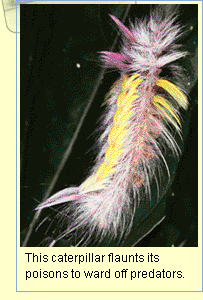
| Brazilian River Otters | |
| Mexican Wild Cats | |
 |
|||
|
The first task of Earthwatch team members is to find the caterpillars.
Munched upon leaves, a curled leaf, and of course, frass (term ecologists
use for caterpillar droppings) are all signs of caterpillar activity.
After samples of the host plant are collected, volunteers watch and
record carefully how a caterpillar reacts to, or avoids potential predators
like birds or rodents. Each caterpillar species has special adaptations
to help it survive in its habitat.
Earthwatch team members then place the caterpillar in a plastic bag,
hang it on a clothesline in a caterpillar "zoo," and examine it daily
for signs of internal enemies. Wasps or flies might have laid eggs that
are growing inside the caterpillar's body. If a caterpillar finally
survives to adulthood, volunteers record the time period, and the kind
of butterfly or moth that emerges.
So far, Dr. Dyer and Dr. Gentry have documented the behaviors and
life histories of over 300 species of caterpillars. Many more species
of caterpillar remain to be discovered. Their research brings practical
benefits. One benefit is replacing harmful pesticides with the natural
enemies of caterpillars to control caterpillar destruction of farmers'
crops.
Photo courtesy of Dr. Grant Gentry/Earthwatch Institute |
|||
 Caterpillars
have a significant effect on the numbers and types of plants in the rainforest.
According to some scientists, they may eat more leaves than all other
Caterpillars
have a significant effect on the numbers and types of plants in the rainforest.
According to some scientists, they may eat more leaves than all other